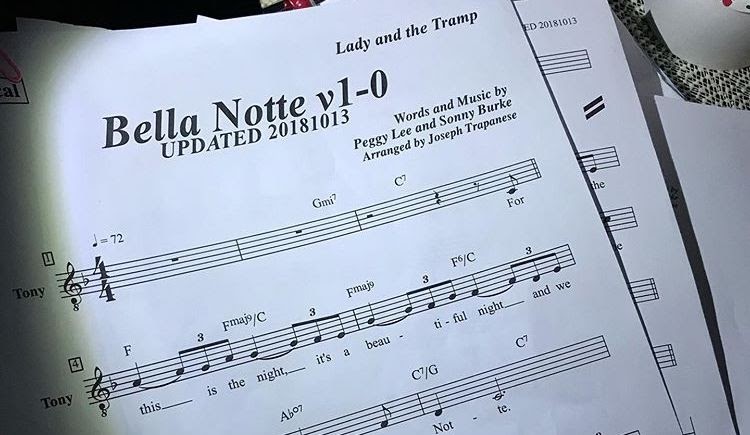Disney’s For Scores podcast, hosted by John Burlingame, continues to take deep dives into the lives and careers of composers who lend their talents to Disney’s most recent films. The newest episode is an interview with Joseph Trapanese, a New Jersey native with Italian heritage who most recently scored the Disney+ live-action adaptation of Lady and the Tramp. It was a revealing conversation that also touched on his first Disney film, TRON: Legacy.
Joe’s big break in film was when he was invited to work with Daft Punk on what became TRON: Legacy. The electronic music duo was worried about being paired with an experienced Hollywood composer, fearing they would try to change their style too much. “I was green enough,” Joe laughs on the podcast. “I wasn’t completely green, but I was green enough for that project.” His collaboration with Daft Punk started before they even saw a script, about two years before the film was released. It was both Joe Trapanese’s introduction to Disney and working with other artists. “I was young and cheap, I was affordable.”
“I fell in love with film music through Star Wars,” he shares while talking about his early interests in music compositions. Growing up with computers and having an appreciation for hip hop led to his earliest experiements making music with synthesizers on a computer. TRON: Legacy opened the door to other collaborations with artists like M83 on Oblivion and Dr. Dre on Straight Outta Compton. His work extends beyond film, working on songs for pop artists like Kelly Clarkson and Moby. And he also worked with John Debney, another For Scores interviewee, on Fox’s The Greatest Showman.
Joe Trapanese first met Director Charlie Bean on TRON: Uprising, the short lived Disney XD animated series that connects the original TRON to the sequel. They now live in the same neighborhood and are good friends. When Charlie Bean was hired to direct the live-action version of Lady and the Tramp, Joe soon found himself discussing the project with the director over drinks. The animated film was part of Joe’s childhood, but he hadn’t seen it in many years. Rewatching it reminded him that it was made in the 1950’s while the story took place that the turn of the century. One of his first thoughts was making it sound like it was of the period it takes place in.
The New Orleans setting allowed Joe to incorporate Jazz into the musical language of the film and shooting in Savannah, GA, gave him access to some legendary musicians. Sarah Morrow was brought on to help with the arrangements of songs that would be used from the animated film. She was Dr. John’s producer and played with Ray Charles. She helped find the musicians, many of whom don’t read sheet music. “Music is alive in New Orleans in a very special way,” Joe says in the podcast.
https://www.instagram.com/p/B1motbGhJUF/?utm_source=ig_web_copy_link
Joe’s starting point to discover the musical style of the film was found through recording multiple versions of “He’s a Tramp,” with a goal of transforming a distinctly 1950’s sounding Peggy Lee song into something that could be a standard of the early 1900’s like “You Made Me Love You.” Nate Wonder, one of Janelle Monáe’s producers, was a big part of this process as Monáe was already cast as Peg. Janelle’s team took on the new cat song and came to Joe’s sessions to match the sound with the goal of audiences not realizing that it was written or arranged by someone else.
Trapanese was excited to add sleigh bells to the score for the Christmas scenes. He re-recorded the arrangements for “Peace on Earth,” but kept Donald Novis’ vocals from the animated film. Disney went into the vault to find the master tapes for him. For the finale, he added a choral version of “Peace on Earth” the way the original filmmakers intended. It wasn’t used in the animated film, but did appear that way on a Disneyland Records recording sung by Teri York.
Various New Orleans musical styles went into the score, particularly on themes that follow Tramp. Piedmont Blues, guitar and harmonica all follow the character and some of the musicians appear in the film. The harmonica player, for example, can be seen in a shot where Tramp is walking through the town. Joe even found himself being cast as a member of the band on the riverboat while visiting the set to assist with some of the on-screen musical sequences.
Lady’s character is scored with more classical, traditional styles. Joe’s favorite scene is a moment where the two styles begin to mix while Lady and Tramp enjoy a river cruise. Tramp’s theme begins to play in Lady’s style before the two are woven together.
A “Home Theme” was inspired by Aaron Copeland’s Americana style to add another dynamic to the score. The New Orleans musical influence even found its way into the store. Keen eyed viewers may have noticed that Jim Dear is a musician and Darling is a singer.
In total, the Disney+ version of Lady and the Tramp employed eighty-six musicians, sixteen vocal performers, and four percussionists. All of this was required to make the score feel as rich and textured as the on-screen shots that ultimately lead to something that feels new and nostalgic at the same time. For more musical fun, be sure to listen to Disney’s For Scores podcast.

